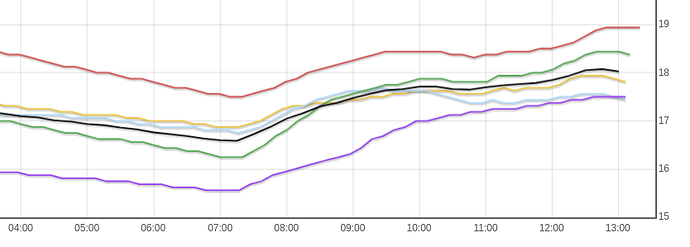My “plant room” is the airing cupboard at the top of the stairs, and is considerably hotter than anywhere else in the house. So, I don’t use the RoomTemperatureZone1 reading as it’s not representative. [There’s also no room left in the cupboard for airing any washing, but that’s not important]
Instead I have 5 wireless thermometers that are continuously read by an old Pi under the stairs. This gives me a reasonably good average for the whole house. One of the bedrooms is south-facing, occupied all day, and has several heat sources, so is much warmer than the rest of the house, but is countered by a couple rooms on the north end that are naturally cooler than the others [I don’t do micro-zoning].
When there’s no solar gain going on, and the heat pump is the primary source, then the room temperatures are typically within 1 degree of the average (black line). The lounge (orange line) is usually close to the average; the room stat that controls the heating is also in the lounge.
I use this average temperature to “turn off” the heat pump when the house is deemed warm enough, overriding the room stat. (I’ve documented the issues with my room stat elsewhere)
Family members opening windows and doors as soon as the sun comes out is a challenge for any heating system. I find myself turning it off manually at the room stat, and then having to leap out of bed early the next morning when I remember I’ve not turned it back again.
It does seem daft to be heating the house in the morning on days which are going to become warm out anyway. I do have forecast temperatures in my system, so I could try predicting it, but not sure it’s worthwhile. Since I’ve [just] gotten onto RHI, which will more than cover running costs, I try not to worry about it so much.
